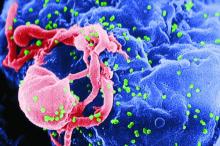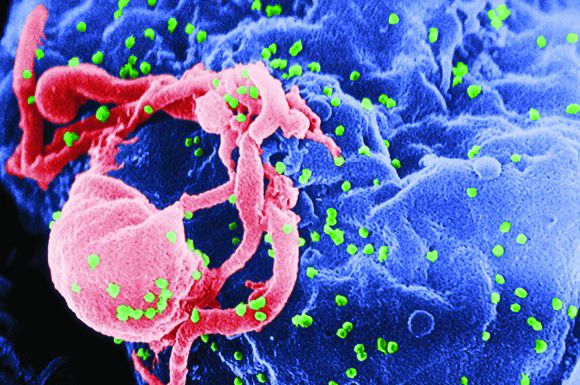User login
Immediate initiation of combined antiretroviral therapy (ART) shows benefits in reducing all-cause mortality in non-AIDS HIV-positive patients aged 50 years or older, according to Sara Lodi, PhD, and her associates.
In a study of 9,596 eligible patients, 2,672 (28%) were U.S. veterans. Results found the 5-year risk of all-cause mortality under immediate ART initiation was 5.3% in the general HIV population and 14.4% in the veterans. The 5-year risk of all-cause mortality was 0.40% lower for the general HIV population and 1.61% lower for veterans compared with immediate initiation versus initiation at CD4 below 350 cells/mm3.
Results also showed rates of all-cause mortality and non-AIDS mortality per 1,000 person-years were 12.3 and 6.3 for the general HIV population and 42.4 and 9.7 for the veterans. In both populations, the observed rates of all-cause and non-AIDS mortality were higher for males and for individuals with lower CD4 count and older age at baseline.
“Immediate initiation of ART appears to be beneficial in reducing all-cause mortality in AIDS-free patients aged 50 years or older, despite their low baseline CD4 count,” the researchers concluded. “More effort should be made into diagnosing HIV earlier, particularly in older patients in order to ensure timely initiation of treatment and follow-up for concomitant comorbidities, thereby maximizing the benefit of early treatment for HIV.”
The study was funded by grants from the NIH and the UK Medical Research Council. Several of the investigators disclosed receiving grants from a number of drug companies.
Read the study in JAIDS (doi: 10.1097/QAI.0000000000001498).
Immediate initiation of combined antiretroviral therapy (ART) shows benefits in reducing all-cause mortality in non-AIDS HIV-positive patients aged 50 years or older, according to Sara Lodi, PhD, and her associates.
In a study of 9,596 eligible patients, 2,672 (28%) were U.S. veterans. Results found the 5-year risk of all-cause mortality under immediate ART initiation was 5.3% in the general HIV population and 14.4% in the veterans. The 5-year risk of all-cause mortality was 0.40% lower for the general HIV population and 1.61% lower for veterans compared with immediate initiation versus initiation at CD4 below 350 cells/mm3.
Results also showed rates of all-cause mortality and non-AIDS mortality per 1,000 person-years were 12.3 and 6.3 for the general HIV population and 42.4 and 9.7 for the veterans. In both populations, the observed rates of all-cause and non-AIDS mortality were higher for males and for individuals with lower CD4 count and older age at baseline.
“Immediate initiation of ART appears to be beneficial in reducing all-cause mortality in AIDS-free patients aged 50 years or older, despite their low baseline CD4 count,” the researchers concluded. “More effort should be made into diagnosing HIV earlier, particularly in older patients in order to ensure timely initiation of treatment and follow-up for concomitant comorbidities, thereby maximizing the benefit of early treatment for HIV.”
The study was funded by grants from the NIH and the UK Medical Research Council. Several of the investigators disclosed receiving grants from a number of drug companies.
Read the study in JAIDS (doi: 10.1097/QAI.0000000000001498).
Immediate initiation of combined antiretroviral therapy (ART) shows benefits in reducing all-cause mortality in non-AIDS HIV-positive patients aged 50 years or older, according to Sara Lodi, PhD, and her associates.
In a study of 9,596 eligible patients, 2,672 (28%) were U.S. veterans. Results found the 5-year risk of all-cause mortality under immediate ART initiation was 5.3% in the general HIV population and 14.4% in the veterans. The 5-year risk of all-cause mortality was 0.40% lower for the general HIV population and 1.61% lower for veterans compared with immediate initiation versus initiation at CD4 below 350 cells/mm3.
Results also showed rates of all-cause mortality and non-AIDS mortality per 1,000 person-years were 12.3 and 6.3 for the general HIV population and 42.4 and 9.7 for the veterans. In both populations, the observed rates of all-cause and non-AIDS mortality were higher for males and for individuals with lower CD4 count and older age at baseline.
“Immediate initiation of ART appears to be beneficial in reducing all-cause mortality in AIDS-free patients aged 50 years or older, despite their low baseline CD4 count,” the researchers concluded. “More effort should be made into diagnosing HIV earlier, particularly in older patients in order to ensure timely initiation of treatment and follow-up for concomitant comorbidities, thereby maximizing the benefit of early treatment for HIV.”
The study was funded by grants from the NIH and the UK Medical Research Council. Several of the investigators disclosed receiving grants from a number of drug companies.
Read the study in JAIDS (doi: 10.1097/QAI.0000000000001498).
FROM THE JOURNAL OF ACQUIRED IMMUNE DEFICIENCY SYNDROMES

